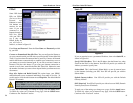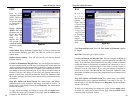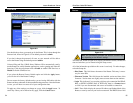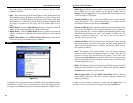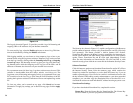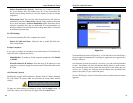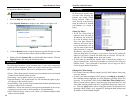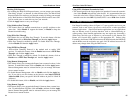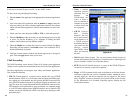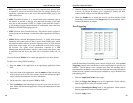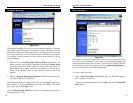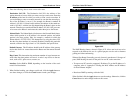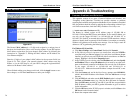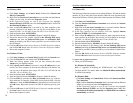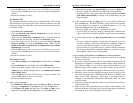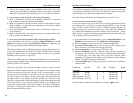
EtherFast
®
Cable/DSL Routers
67
Instant Broadband
™
Series
66
• Telnet A terminal
emulation protocol
commonly used on
Internet and
TCP/IP-based net-
works. It allows a
user at a terminal or
computer to log onto
a remote device and
run a program.
• SMTP (Simple
Mail Transfer
Protocol) The stan-
dard e-mail protocol
on the Internet. It is
a TCP/IP protocol
that defines the mes-
sage format and the
message transfer
agent (MTA), which
stores and forwards
the mail.
• DNS (Domain Name System) The way that Internet domain names are
located and translated into IP addresses. A domain name is a meaningful and
easy-to-remember “handle” for an Internet address.
• TFTP (Trivial File Transfer Protocol) A version of the TCP/IP FTP proto-
col that has no directory or password capability.
• Finger A UNIX command widely used on the Internet to find out informa-
tion about a particular user, such as a telephone number, whether the user is
currently logged on, and the last time the user was logged on. The person
being “fingered” must have placed his or her profile on the system in order
for the information to be available. Fingering requires entering the full
user@domain address.
Figure 9-18
If you need to forward all ports to one PC, see the “DMZ” section.
To add a server using Port Range Forwarding:
1. Enter the name of the application in the appropriate Customized Applications
field.
2. Next to the name of the application, enter the number or range of the exter-
nal port(s) used by the server or Internet application in the Ext. Port column.
Check with the Internet application software documentation for more infor-
mation.
3. On the same line, select the protocol UDP or TCP, or select both protocols.
4. Enter the IP address of the server that you want the Internet users to be able
to access. To find the IP address, go to “Appendix F: Finding the MAC
Address and IP Address for Your Ethernet Adapter.”
5. Check the Enable box to enable the services you have defined. Port Range
Forwarding will not function if the Enable button is left unchecked. This is
disabled (unchecked) by default.
6. Configure as many entries as needed—the Router supports up to 10 ranges of
ports. Click the Apply button when you are done.
UPnP Forwarding
The UPnP Forwarding screen, shown in Figure 9-18, displays preset application
settings as well as options for customization of port services for other applications.
The Preset Applications are among the most widely used Internet applications.
They include the following:
• FTP (File Transfer Protocol) A protocol used to transfer files over a TCP/IP
network (Internet, UNIX, etc.). For example, after developing the HTML pages
for a website on a local machine, they are typically uploaded to the web server
using FTP. FTP includes functions to log onto the network, list directories, and
copy files. It can also convert between the ASCII and EBCDIC character codes.
FTP operations can be performed by typing commands at a command prompt
or via an FTP utility running under a graphical interface such as Windows. FTP
transfers can also be initiated from within a web browser by entering the URL
preceded by ftp://.



